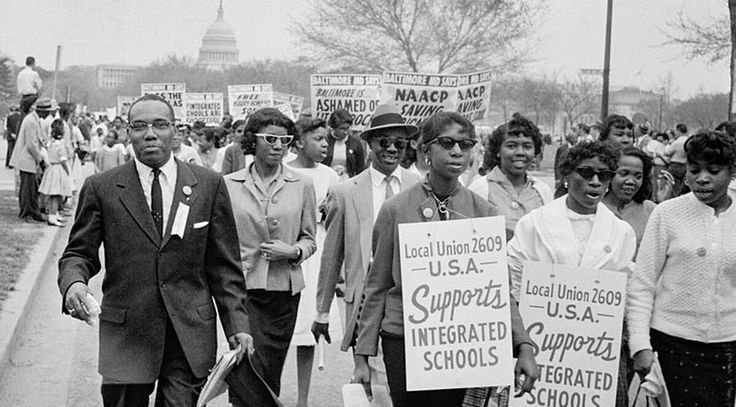The Civil Rights Movement: A Fight for Equality and Justice

The Civil Rights Movement was a defining period in American history, marked by the fight against racial segregation, discrimination, and systemic oppression. It was a battle for equality that relied on nonviolent resistance, legal challenges, and grassroots activism. African Americans, along with allies from various backgrounds, pushed for fundamental rights that had been denied to them for centuries. This movement reshaped the nation’s legal and social structures, bringing significant victories but also facing intense opposition.
Historical Background
The origins of the Civil Rights Movement can be traced back to the post-Civil War era, when African Americans briefly experienced political and social progress during Reconstruction However, with the rise of Jim Crow laws in the late 19th and early 20th centuries, racial segregation became deeply entrenched in American society.
Southern states enacted laws that mandated separate schools, transportation, restaurants, and public facilities for Black and white citizens. Voting rights were systematically denied through literacy tests, poll taxes, and intimidation tactics. Legal racial discrimination was upheld by the Supreme Court in its 1896 decision in Plessy v. Ferguson, which established the doctrine of “separate but equal”.
Despite these restrictions, African Americans continued to resist. Organisations like the NAACP, founded in 1909, worked through legal avenues to challenge segregation, and Black communities built their own institutions to support education, business, and culture. The experiences of Black soldiers in World War II, who fought for freedom abroad while facing discrimination at home, further fuelled the demand for civil rights.
The Montgomery Bus Boycott (1955–1956)
The Civil Rights Movement gained national attention in December 1955, when Rosa Parks, an African American woman, refused to give up her seat to a white passenger on a segregated bus in Montgomery, Alabama. Parks’ arrest sparked the Montgomery Bus Boycott, a mass protest against racial segregation in public transportation.
Led by Dr. Martin Luther King Jr., the boycott lasted for over a year, as African Americans refused to use the city’s buses, organising carpools and walking miles instead. The protest put economic pressure on the bus system and demonstrated the power of nonviolent resistance.
In 1956, the Supreme Court ruled that bus segregation was unconstitutional, marking a major victory for the movement. The Montgomery Bus Boycott not only desegregated public transportation but also established King as a national leader in the fight for civil rights.
School Desegregation and the Little Rock Nine (1957)
Following the Supreme Court’s decision in Brown v. Board of Education (1954), which declared school segregation unconstitutional, many Southern states resisted integration. One of the most infamous confrontations occurred in Little Rock, Arkansas, in 1957.
Nine Black students, known as the Little Rock Nine, attempted to integrate Central High School, but they were met with violent white mobs. Arkansas Governor Orval Faubus defied federal law by calling in the National Guard to block the students’ entry. In response, President Dwight D. Eisenhower sent federal troops to escort the students safely into the school.
The Little Rock crisis highlighted the federal government’s role in enforcing civil rights laws and demonstrated the fierce opposition to desegregation in the South.
The Sit-in Movement and the Student Nonviolent Coordinating Committee (SNCC) (1960)
On February 1, 1960, four Black college students in Greensboro, North Carolina, sat at a segregated lunch counter at Woolworth’s and refused to leave. Their peaceful protest sparked a wave of sit-ins across the country, as thousands of students joined in similar demonstrations.
The sit-in movement led to the creation of the Student Nonviolent Coordinating Committee (SNCC), a student-led civil rights organisation that played a crucial role in protests, voter registration drives, and Freedom Rides. The movement successfully pressured many businesses to desegregate their facilities and empowered young activists to take leadership roles in the struggle for equality.
The Freedom Rides (1961)
The Freedom Rides, organised by the Congress of Racial Equality (CORE) and SNCC, aimed to challenge segregation in interstate travel. Black and white activists rode buses together through the South, testing the Supreme Court’s ruling that segregation in bus terminals was illegal.
The riders faced brutal violence, including mob attacks and firebombed buses. In Anniston, Alabama, one bus was set on fire, and the passengers were nearly killed. Despite the dangers, the Freedom Riders persisted, drawing national attention to the injustice of segregation. Eventually, the federal government intervened, enforcing desegregation in bus terminals.
The Birmingham Campaign (1963)
Birmingham, Alabama, was one of the most segregated cities in America. In 1963, Dr. Martin Luther King Jr. and the Southern Christian Leadership Conference (SCLC) launched a campaign to desegregate the city’s businesses and public facilities.
Peaceful protesters, including children, were met with extreme violence from the police, who used fire hoses and attack dogs against them. Images of the brutality were broadcast across the nation, shocking the public and increasing pressure on the federal government to act.
During his imprisonment in Birmingham, King wrote the famous “Letter from Birmingham Jail,” in which he defended civil disobedience and nonviolent protest as necessary for social change.
The Birmingham Campaign was a turning point in the movement, forcing President John F. Kennedy to propose major civil rights legislation.
The March on Washington and the Civil Rights Act
The March on Washington for Jobs and Freedom, which took place on August 28, 1963, was a monumental event in the Civil Rights Movement, drawing over 250,000 people to demand justice, equality, and economic opportunity. It was during this powerful gathering that Dr. Martin Luther King Jr. delivered his famous “I Have a Dream” speech, which resonated deeply with the public and called for racial equality, unity, and the end of discrimination. The march not only galvanized support for civil rights but also played a pivotal role in pushing forward the passage of the Civil Rights Act of 1964. Signed into law by President Lyndon B. Johnson, the Act was a transformative piece of legislation that banned segregation in public places, prohibited discrimination in employment based on race, color, religion, sex, or national origin, and empowered the federal government to enforce these rights more effectively. This law was a critical step in dismantling institutionalized racism and promoting greater equality in the United States.
The Selma March and the Voting Rights Act (1965)
Despite the Civil Rights Act, many African Americans in the South were still denied the right to vote due to discriminatory practices. In response, activists organised a voting rights campaign in Selma, Alabama.
On March 7, 1965, a group of peaceful marchers attempted to walk from Selma to Montgomery, demanding voting rights. They were met with violent attacks from state troopers on the Edmund Pettus Bridge, in what became known as “Bloody Sunday.” The brutality was televised, sparking national outrage.
Following continued protests, Congress passed the Voting Rights Act of 1965, which outlawed literacy tests and other discriminatory voting restrictions. This law significantly increased Black voter registration and participation in elections.
Challenges and Resistance
Despite the significant achievements of the Civil Rights Movement, it faced intense opposition and resistance from various quarters. White supremacist groups, notably the Ku Klux Klan, engaged in violent acts, including bombings, attacks, and assassinations to intimidate activists and suppress the movement’s progress. Many Southern politicians openly defied federal laws and court rulings, maintaining segregationist policies and practices. The movement also suffered devastating losses as key figures, such as Medgar Evers, Malcolm X, and Dr. Martin Luther King Jr., were assassinated for their tireless advocacy for racial justice. The continued racial and economic inequality fostered growing frustration, leading to divisions within the movement. Some activists, feeling that nonviolent protest had not achieved sufficient progress, began to advocate for more militant approaches, such as those promoted by the Black Power movement, which called for greater self-determination and empowerment for Black Americans.
Conclusion
The Civil Rights Movement transformed American society. It ended legal segregation, secured voting rights, and inspired future movements for social justice, including the fight for LGBTQ+ rights, gender equality, and immigrant rights. However, systemic racism and economic disparities persist, and the struggle for racial justice continues today.
The movement demonstrated the power of grassroots activism, civil disobedience, and legal advocacy in challenging oppression. Its legacy serves as a reminder that progress requires persistent effort, unity, and courage in the face of injustice.


